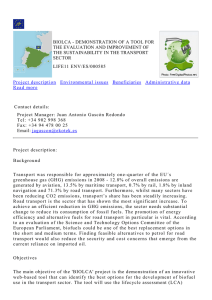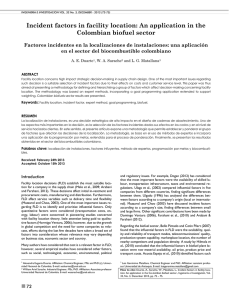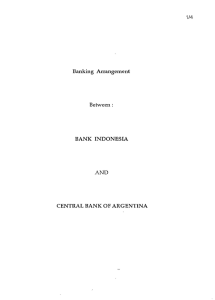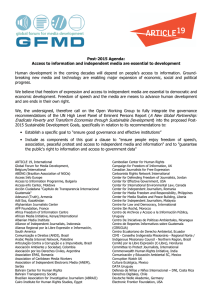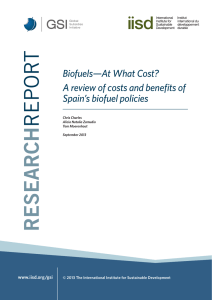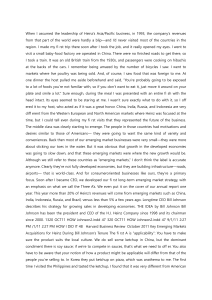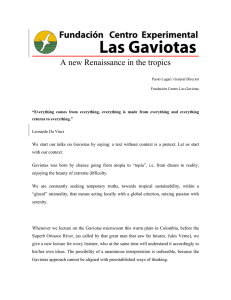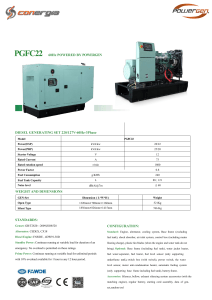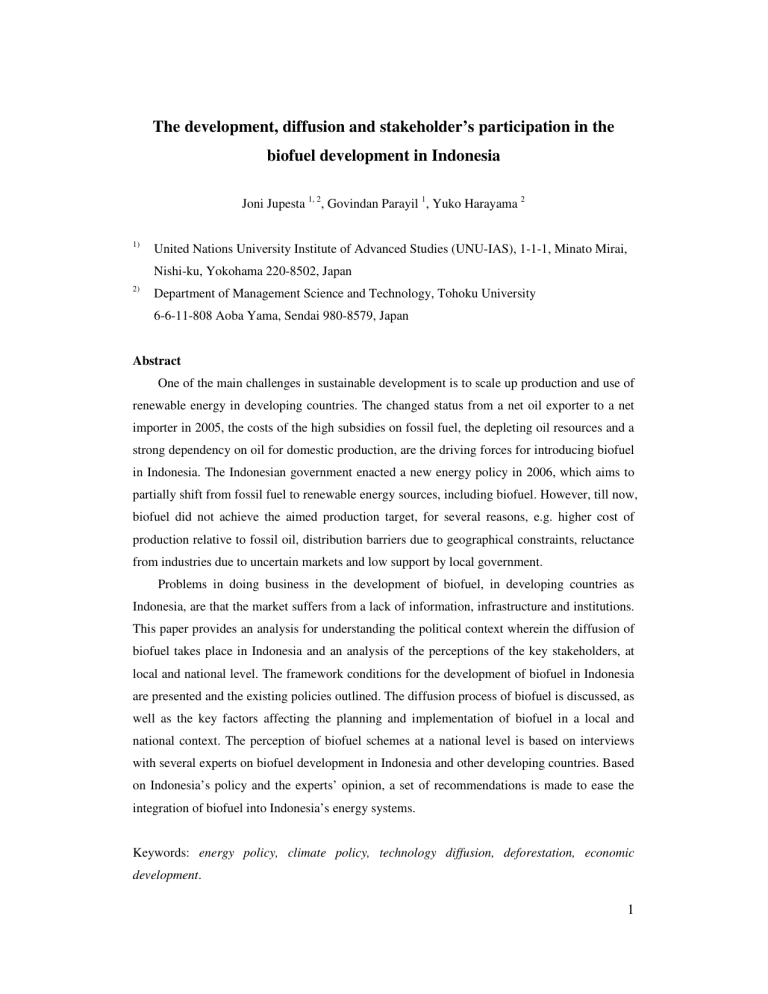
The development, diffusion and stakeholder’s participation in the biofuel development in Indonesia Joni Jupesta 1, 2, Govindan Parayil 1, Yuko Harayama 2 1) United Nations University Institute of Advanced Studies (UNU-IAS), 1-1-1, Minato Mirai, Nishi-ku, Yokohama 220-8502, Japan 2) Department of Management Science and Technology, Tohoku University 6-6-11-808 Aoba Yama, Sendai 980-8579, Japan Abstract One of the main challenges in sustainable development is to scale up production and use of renewable energy in developing countries. The changed status from a net oil exporter to a net importer in 2005, the costs of the high subsidies on fossil fuel, the depleting oil resources and a strong dependency on oil for domestic production, are the driving forces for introducing biofuel in Indonesia. The Indonesian government enacted a new energy policy in 2006, which aims to partially shift from fossil fuel to renewable energy sources, including biofuel. However, till now, biofuel did not achieve the aimed production target, for several reasons, e.g. higher cost of production relative to fossil oil, distribution barriers due to geographical constraints, reluctance from industries due to uncertain markets and low support by local government. Problems in doing business in the development of biofuel, in developing countries as Indonesia, are that the market suffers from a lack of information, infrastructure and institutions. This paper provides an analysis for understanding the political context wherein the diffusion of biofuel takes place in Indonesia and an analysis of the perceptions of the key stakeholders, at local and national level. The framework conditions for the development of biofuel in Indonesia are presented and the existing policies outlined. The diffusion process of biofuel is discussed, as well as the key factors affecting the planning and implementation of biofuel in a local and national context. The perception of biofuel schemes at a national level is based on interviews with several experts on biofuel development in Indonesia and other developing countries. Based on Indonesia’s policy and the experts’ opinion, a set of recommendations is made to ease the integration of biofuel into Indonesia’s energy systems. Keywords: energy policy, climate policy, technology diffusion, deforestation, economic development. 1 1. Introduction One of the main challenges in sustainable development is to scale up the production of renewable energy in developing countries. The adoption and diffusion of low carbon technologies need to be seen as innovation processes. A technology-innovation process has several stages: R&D, demonstration, deployment and diffusion at commercial scale. Shifting energy consumption from fossil fuel to biofuel is considered an option for climate change mitigation. In case of a developing country, technology leapfrogging is one way to avoid the resource intensive patterns of economic and energy development. One of the common features of this technology leapfrogging is technology transfer. In the climate context, technology transfer is defined as a broad set of processes covering the flow of know-how, experience and equipment [1]. The changed status from a net oil exporter to net importer in 2004, the highly subsidized price of fossil fuel, the depleting oil resources and a strong dependency on oil and gas export for government`s revenues are the driving forces for introducing biofuel in Indonesia. Globally, the development of renewable energy markets relies on political support in terms of subsidy and carbon tax and on the decision maker interest, i.e.: voters in general elections, climate agreement such as the Kyoto Protocol and the Copenhagen Accord, oil politics in the Middle East, etc. The new autonomy policy of the central Indonesian government gives a bigger role to the local authorities. Spread over 33 provinces, the biofuel industries could be more competitive in one region than other regions depending on the interests and support of the local authorities. The Indonesian government enacted a new energy policy in 2006 which aims to partially shift the use of fossil fuel into renewable energy sources, including biofuel. To show the government’s strong commitment, just over 10 million hectares of land have been allocated to the production of biofuel crops. The mandatory requirement to use biofuel and the given subsidies will help to make biofuel competitive. However, till now, biofuel still did not achieve the politically set targets, for several reasons, e.g. higher cost of production relative to fossil fuel, distribution barriers due to geographical constraints, reluctance from industries due to uncertain markets and a relative low participation from local government. The objective of this chapter is to provide an in depth analysis of the Indonesian energy system and to assess the possibilities for the diffusion of biofuel. This diffusion process involves the perception by the key stakeholders at local and national level. The analytical framework conditions for biofuel development in Indonesia will be presented and the existing policies will 2 be outlined. Based on the analytical framework, the problems for the diffusion process of biofuel are discussed, as well as key factors affecting the planning and implementation of biofuels in a local and national context. This chapter uses an analytical framework for understanding the process of diffusion of biofuel in Indonesia. Various factors which affect the diffusion and adoption of this new technology are classified into technology, economics development, sustainability and policy. The stakeholders in the biofuel industries are: producers, users, academics, policy makers and the international market. The analytical categories are applied to an in depth study of the diffusion of biofuel in Indonesia. Biofuel is now mainly used for transportation but will extend into other demand sectors: power generation, industry and commercial use. This chapter is structured as follows: Section 2 describes the mix energy policy in Indonesia as the driving force for the biofuel development, section 3 describes an analytical framework for studying the diffusion processes of biofuel development in Indonesia. Section 4. outlines the diffusion process based on the analytical framework. The conclusions are given in Section 5. 2. Indonesia Mix Energy Policy Energy Mix 2006 Hydro 3% Energy Mix 2025 Geother mal 1% Biofuel 5% Hydro, others 5% Gas 29% Oil 20% Gas 32% Coal 15% Geo 5% Oil 52% Coal 33% Fig.1. Indonesia’s Mix Energy Policy. 3 In 2008, the fuel and electricity subsidies amounted to 14 and 6 billion US$, respectively, equaling the total central governmental capital and social spending. Oil and gas contributed to ~32% of government revenues in 2006, but decreased to ~20 % in 2008, in accordance with depleting oil resources and an oil production decrease from 9×109 barrels in 1987 to half of that in 2007 [4]. For these reasons, the government enacted the so-called Mix Energy Policy (in 2006), to reduce dependency on oil by the use of a mixture of energy sources. The government hoped to utilize local resources to make renewable energy (e.g. biofuel). The target was to reduce the share of fossil oil in providing energy from 52% of total energy consumption (as in 2006) to 20% by 2025. By that year, the remaining energy should come from coal (35%) and gas (30%), whilst renewable energy sources are hoped to provide 15% of total energy consumption. Fig. 1. shows the Mix Energy Policy based on the Presidential Decree No. 5 (2006), which states that the share of renewable (geothermal and hydropower) will increase from 4% to 15% within 20 years [2]. Biofuel was introduced with the objective of fulfilling 5% of the total energy consumption by 2025. It was expected that biofuel development could create at least 4 and 7x106 jobs by 2010 and 2025, respectively. In 2008, the transportation sector consumed 26x 106 ton oil equivalent (Mtoe), as depicted in Table 1. The replacement of 5–20% of this oil by biofuel will reduce 1.5–6 ×109 liters of fossil oil consumption per annum. Because the transportation sector used 30% of the total energy consumed in 2008 (in this calculation, biomass derived energy for cooking in rural areas is excluded), a mixture of biofuel with gasoline and diesel fuel can significantly diminish oil consumption on a national scale [5]. Table 1. Fuel consumption in the transportation sector in Indonesia (in 106 ton oil equivalent; Mtoe). Gasoline Diesel fuel Others (biofuel) Total Transportation Final Energy Consumption 3. 2000 2002 2004 2006 2008 10.6 8.4 n/a 19.0 11.9 8.8 n/a 20.7 14.6 9.7 n/a 24.3 14.6 7.9 0.2 23.2 17.2 7.9 0.9 26.1 Growth (%) 7.43 –0.74 116.67 4.68 63.9 65.6 73.0 72.0 87.8 4.68 Analytical framework for the diffusion process of biofuel development The analytical framework used to study the development of biofuel development in 4 Indonesia is that of a technological innovation system (TIS) [2]. This section outlines the structural components of such a system, and how the diffusion process is determined from different perspectives, i.e.: technology, economics, sustainability and policy. The analytical framework is depicted in Fig. 2. The various factors will influence the stakeholders in the diffusion process. 3.1. Actors and knowledge creation The biofuel framework can be characteristic as specialized and highly integrated. There are a number of institutions (universities, research institutes and firms) involved in a range of research and development activities, but the present cooperation and research coordination are not optimal yet. The flow of information among the actors is limited and most of the times fragmented. There is competition due to scarcity of funding sources and links. There are several actors regarding the biofuel diffusion process: producers, users, academic, policy maker and international market. Sustainability • Climate change • Deforestation • Food security Economics • Job creation • Oil price • Investment • Producers • Users • Academics • NGO • Policy maker • International market Policy • Tax • Subsidy • Energy • Climate Technology • Innovation R&D • Process efficiency • Energy efficiency Fig. 2. The diffusion process in biofuel development in Indonesia 5 The producers are the local farmers and the industries. While the industries usually own the plantation and biofuel processing, the farmers usually only produce the biofuel crops and sell it to industry. The biofuel industries in Indonesia are run by local companies and international companies. The technology suppliers are from Lurgi (Germany), Japan Gasoline Company (Japan), Delta (USA), Praj Industries (India), CAMC (China). Currently, there are 5 companies with production around 15% of total capacity due to raw material scarcity and low domestic demand for biofuel [3]. There are five main producers: the Eterindo group, Molindo, Wilmar, Sumiasih and Musim Mas. PT Eterindo Wahanatama is a chemical industry. Established on 1992, the company has been listed on the Jakarta Stock Exchange in 1997. This company uses Crude Palm Oil (CPO) as feedstock to produce biodiesel in Gresik, East Java. The total capacity is 240,000 MT/ year. PT Molindo is the largest ethanol producer in Indonesia. The company has developed biofuel from molasses and produces 55 Ml/year. The company invested 25x106 US$ to increase ethanol production capacity to 100 Kl/year by developing a new plant in Lampung area. PT Molindo cooperates with PTPN X (sugar mills) to secure 100,000-150,000 tons of molasses for its ethanol production. In addition, the company will open 7,000-10,000 hectares of cassava plantation for alternatives feedstock. Wilmar Group is a foreign investment company from Malaysia and is the largest palm biodiesel manufacturer in the world. In Indonesia, this company’s plant is located in Dumai and produces 350,000 MT/year. The future expansion will reach 106 MT/year. PT Sumiasih was established in 1982 as an oleo-chemical manufacturer from CPO. This company started to produce biodiesel in 2006 with a production capacity of 36 kton per year. The plan is to expand capacity of the biodiesel plant in West Java by an investment of 8x106 US$ and build a new biodiesel plant in Lampung with a possible investment of 28x106 US$. PT Musim Mas is also based on biodiesel palm oil and has an installed capacity of 300 kton. The international investment are come from the US, Japan, China, India, South Korean, Brazil, Malaysia and Germany. The US Agency for International Development (USAID), through its Agribusiness Market and Support Activities (AMARTA) program, is interested in partnership with Development Alternatives Inc. Japanese investment companies are from Mitsubishi, Ithocu and Mitsui besides the Japanese bank for International Cooperation (JBIC). China invests through the China National Offshore Oil Corporation (CNOOC) and Hong Kong Energy and is considered to be one of the biggest investments in the biofuel sector. The companies together with the local company Sinar Mas invest 5.5x109 US$ in Papua and the Kalimantan region. This project is based on (palm oil) biodiesel and (sugarcane and cassava) 6 bio-ethanol. The Chinese government invests through the Malindo project. Each hectare of plantation requires 3,297 US$ for palm oil, 1,648 US$ for sugarcane, 330 US$ for Jatropha curcas and 3,846 US$ for cassava. In future a huge expansion is expected for the biofuel processing plant due to the mandatory use of biofuel in the domestic market and high international demand. The domestic demand so far is in the transportation sector, but will expand soon into industries, commercial and power generation. In 2007, 58 joint cooperation agreements were reportedly signed with a total investment value of 12.5x109 US$. In 2008, several other companies committed themselves to invest in the biofuel industry: Sinopec from China, the Sampoerna Group, Bronzeak from the UK, and Samsung from South Korea. The universities act as the center of research and development which provides the source for skills and knowledge labor. There are four leading universities for technology commercialization in Indonesia: the University of Indonesia, the University of Gajah Mada, the Institute of Agriculture Bogor and the Bandung Institute of Technology. Environmental NGOs act as watch dogs over biofuel production to ensure the suitability of biofuel production in terms of environmental protection and sustainable production. Several NGOs are interested in biofuel development in Indonesia: Greenpeace, Sawit Watch, Pelangi, etc. Most of the NGOs are nonprofit organization with external funding from international donors. The government is the policy maker; the wide spectrum stakeholder of biofuel development is society at large, as the user and producer (local farmers). The policy makers are local and central government. Local government sets up the infrastructure such as roads for transportation of biofuel from plantations. The National Team of Biofuel Development acts as the policy maker at the central level and the National Team of the SSEV Development acts as the policy maker at the local level. Both reside under the Ministry of Energy and Coordinating Ministry of Economy respectively. The international markets consist of the external buyers: China, Japan and India are (potential) buyers because of requirements derived from their climate policy for renewable energy sources. The corporations such as Cargil, Ithocu and Marubeni show interest in being traders for this commodity. 3.2. Regulatory framework for biofuel development The legal basis for the biofuel development is through Presidential Instruction no.1/2006 regarding “Provision and utilization of Biofuel as Alternative Fuel” on 25th January 2006. 7 Through this regulation there is incentive and tariff for biofuel development and to set simple biofuel trade to incorporated into entire fuel trade system. Considering Indonesia is a vast land there is no problem in finding locations for biofuel plantations. However, availability has changed in May 2010 after the climate agreement between Indonesia with the Norwegian government. In principle almost 13 million hectares land are available for biofuel production, as shown in Table 2.; what part can be used depends on above mentioned agreement. Table 2. Land provision for biofuel development Provinces South East Sulawesi North Sulawesi Nusa Tenggara Timur Area ( ha) 212,123 34,812 101,830 Maluku 2,304,932 Papua 9,262,130 West Kalimantan 514,350 Central Sulawesi 251,856 South Kalimantan 65,638 Total 12,747,671 Land provision is complemented with seed supply. There are several big palm oil companies which also produce seed such as the Palm Oil Center Medan (PPKS), PT. Socfin, PT. Lonsum, Pt. Dami Mas, Pt. Tunggal Yunus, PT. Bina Sawit Makmur, PT. Tania Selatan which sell 147 million seeds per year to be planted in 700,000 hectares of land. Other R&D centers such as those of the Ministry of Agriculture, the Agency of Assessment and Application for Technology (BPPT), Lemigas, and the Bandung Institute of Technology (ITB) also do extensive research in biofuel technology. ITB focuses on conversion technology and the Ministry of Agriculture through the Center for studies in Mechanization in Agriculture focuses on mixing biodiesel and automotive diesel fuel for stationary machineries. The government plans to spend 51 trillion US$ in five years to develop palm oil, rubber and cocoa. Two third of the funds are to be allocated to palm oil plantations. Supported by this policy and high demand, the biofuel development program has attracted private investors both 8 domestic and international. Early in 2007, sixty agreements on biofuel development projects between various parties, including investors and 26 domestic investors have been signed. Altogether, the project’s value was around 9 to 10 x109 US$. The banking sector also invests 3.7x109 US$ in this sector. There are several banks involved: Pt. Bank Negara Indonesia, bank Republic Indonesia, Bank Mandiri, Bank Bukopin, Bank Daerah Sumatera Barat and Bank Daerah Sumatera Utara. The bank interest rate for factories is 14-15% and for small holders 10%. 3.3. Biofuel diffusion schemes Biofuel in Indonesia started selling in 2006 as BioSolar, BioPertamax and BioPremium through PT Pertamina, as shown in the table 7.1. BioSolar is a mix of 2.5% biodiesel in the form of Fatty Acid Methyl Ester (FAME) and 97.5% diesel fuel. BioPremium and BioPertamax both are a mixture of 3% ethanol and 97% gasoline. The difference between BioPremium and BioPertamax is that the gasoline used has an octane number of 88 and 92, respectively. Pertamax Plus has gasoline in it with an octane number of 95. Table 3. The Biofuel Consumption in Indonesia [4] (in 106 barrel oil equivalent) No Product 2006 2007 2008 1 BioSolar 1,408 5,692 6,029 2 BioPremium 9 326 257 3 BioPertamax 0 58 94 1,417 6,076 6,380 The framework integrates several elements with the aim of biofuel development: technology, economics, policy, sustainability and the stakeholders. Technology considers technical knowledge in terms of feedstock supply and energy conversion processes. The innovative R&D is expected to increase the yield and quality of product. The process efficiency addresses the simplification of the process production starting from agriculture and the conversion process. Energy efficiency looks at the efficiency of the energy used in the process. Economics addresses job creation, since biofuel plantations are labor intensive and one of the aims is to alleviate poverty by reducing unemployment. The tax waives and subsidies on biofuel are other aspects discussed. The expected investment should come from domestic and 9 international sources. The biofuel consumption in Indonesia is shown in Table 3. In terms of sustainability, biofuel is assumed to be carbon neutral; however, this depends on the production process of biofuel. Present biofuel production may also threaten food security, since land use could change from food to fuel production. The impact of deforestation due to the expansion of biofuel plantations also is a factor in climate change. There are three related policies in biofuel production: - agricultural policy, since all biofuels come from agriculture products, - energy policy, as biofuel becomes one of the energy sources and - climate policy, as biofuel production and consumption may contribute to climate change. Society Biofuel chain Policy makers Environmental NGOs Industries (processing, distribution) Suppliers (local farmer and plantations) Fig. 3. The stakeholders in biofuel in Indonesia. All four elements interact through the stakeholders’ value. The stakeholders in the biofuel supply chain are given in Fig. 3. The farmers act as the local supplier beside the plantation industries. Private industries act as buyer and the state owned industries act as the distributor (the oil state company Pertamina). NGOs act as the watchdogs to ensure that the biofuel industries act with public interest in mind; Greenpeace’s actions versus Sinarmas is an example of this: in 2010, Greenpeace, one of the foremost NGOs in environmental protection, accused Sinarmas internationally that it does not practice sustainability at its palm oil plantation and this pushed Sinarmas to implement sustainable practices. The policy maker at local level can promote local investment in biofuel industries, while central government is responsible for the tax and subsidy measures to promote biofuel. 10 The National Team of Biofuel Development acts as the policy maker at central level and the National Team of the SSEV Development acts as the policy maker at local level; they reside under the Ministry of Energy and Coordinating Ministry of Economy, respectively. At central government level, biofuel development is the responsibility of the National Team of Biofuel Development. This team has the following objectives: 1) To design a blue print for biofuel production to accelerate poverty alleviation and job creation, 2) To design a road map for biofuel development, 3) To prepare the technical implementation of biofuel and set up an institutional task force, 4) To evaluate the biofuel development and the chances to alleviate poverty and create jobs, 5) To periodically report on the biofuel development to the President. 4. Diffusion process of biofuel development: Indonesia as case study 4.1. Technology The use of biofuels as a transportation fuel has reasserted the linkages between energy and agricultural output markets. Biofuels have multiple benefits related to energy security, socio-economic and climate protection issues. Biofuel, which is mainly used as an energy source for transportation, can improve the energy autonomy of an economy, reducing the dependency on oil and gas. The use of biofuel shows a fast growth because it can curb greenhouse gas emissions as they substitute fossil fuels. One of the parameters used to measure how effective biofuel is in replacing fossil fuel is the energy ratio, i.e. the ratio of energy contained in a biofuel, relative to the fossil fuel energy used for its production. The energy ratio from sugarcane ethanol is 4.9, whilst that of palm oil biodiesel is 3.6. Sugarcane processing technology has already been fully developed compared to palm oil processing. However, the net energy balance, which is the difference between energy output and energy input during production, has the highest value for palm oil compared to all other biofuel crops. A problem that needs solving is balancing the supply and demand of crops for food and fuel purposes. This can be achieved by directing the excess supply for food into fuels, and vice versa. Biofuel, at present, is produced in large quantities in other regions such as the USA, Brazil and Western Europe. In the future, the restriction in the allocation of land and higher 11 feedstock cost in these regions will shift the production of biofuel to other regions that have more land available and have lower feedstock cost, such as Indonesia, Malaysia, Thailand, etc. First generation biofuels have already reached a competitive price in some regions, due to economies of scale and technology learning such as in Brazil, where the price of bio-ethanol is 0.23 US$/l at an oil price 0.25 US$/l [5]. Second generation biofuels are produced from non-food materials such as cellulosic biomass, e.g. wood, rice straw and grass. Another non–food biofuel will be third generation biofuel to be produced from algae. This type of biofuel will have even more advantages as the yield of product is higher than that from first and second-generation technologies. The increasing price of oil will improve the competitiveness of biofuel. Biofuel in Indonesia is being produced with first generation technology. The use of biofuel in Indonesia is expected to reduce energy consumption. Biofuel in Indonesia starts with `bio-premium`, a mixture of gasoline and bio-ethanol, and `bio-solar` a mixture of diesel fuel and biodiesel. In 2007, the mixture was introduced at low level as the infrastructure is still not well equipped. The mixture is only available in big cities such as: Jakarta, Surabaya and Bandung. Later it will expanded into other medium cities with inhabitants more than one million people. The first generation technology is a mature technology. The fermentation process to produce bio-ethanol and the trans-esterification process were developed a century ago. The knowhow of this technology could be adopted through training. Thus, an improvement of this technology can be expected from process efficiency by simplifying the production process. The biofuel yield is expected to be growing due to innovation by R&D. The conversion process is one of the important steps in the whole production chain. A high yield and low energy consumption are important considerations in promoting the future competitiveness of biofuels with fossil fuel in the market. Currently, Indonesia allocates biofuel mainly for biodiesel which is derived from palm oil. Jatropha curcas is only cultivated in dry and arid climate area such as in Sumbawa and the Nusa Tenggara area. Also, R&D is expected to produce seeds of Jatropha curcas with high productivity and resistance to pests. The benefit of Jatropha curcas is that plantations do not have a conflict with food production, since the land used is too infertile for agriculture and currently used only for livestock feedstock. With the same land area, bio-ethanol production is not as productive as biodiesel. In addition, biofuel must compete with other energy resources and low carbon technologies such as solar energy, wind and tidal power, new atomic energies, and other advanced 12 technologies. Later, second and third generation biofuel may be available on a large scale, offering much better perspectives and competitive fuel prices in the long term, between 2020 and 2030. A competitive price may be achieved thanks to the relatively low cost for feedstock and the reduction of production costs of biofuel from lignocelluloses and algae. Altogether, an innovative energy system will create more efficient and effective energy systems by utilizing domestic energy resources, using efficient processes and minimizing fossil fuel consumption during the production process. In general, the ability to produce high yield feedstock seeds in particular to Jatropha curcas and sugarcane are crucial for the technology development for this biofuel and this is rely on the R&D budget for this sector beside capacity development for high skills scientist. The lack of distribution between biofuel production plants locations with feedstock location needs to be resolved. 4.2. Economic development One of the main reasons to push the development of biofuel industries is to minimize fossil oil consumption. In Indonesia, as well as in other developing countries, domestic fuel is still being subsidized. While the fuel subsidy in 2005 amounted to 4.4x109 US$, the fuel subsidies rose to 17.6x109 US$ in 2008, which equals the total capital and social expenditure of government. This is one of the compelling reasons to look at biofuel as a solution to offset the oil subsidies. The economic motive, besides partially decreasing the domestic fossil fuel consumption, is that biofuel could also generate income through export of the excess production and could create jobs in related sectors (agriculture, industries, distribution, trading, etc). So far, biofuel utilization has not reached its set target mainly because of the under-equipped infrastructures (distribution, production and trading) and lack of political support. The investment in biofuel development will be 2.9x109 US$ until 2025 which 2.3x109 US$ for biodiesel development and the rest for bio-ethanol development. The model in previous study showed that the replacement oil with biofuel in the transportation sector could save up to 29x109 US$ in oil consumption in 2025 (at that time, biodiesel produced will be 41 Gtoe and bio-ethanol 14 Gtoe, in the mix scenario) which is equal to 6.7% of GDP in 2007 and 165% of oil subsidies in 2008 [6]. The market potential of biofuel development is huge and has great potential to partially solve Indonesia`s poverty problem and boost economic growth. The price of biofuel in Indonesia is still not competitive with the oil price up to date. This situation happens worldwide. Only in Brazil, has the price of sugarcane bio-ethanol achieved 13 economic competitiveness with gasoline. The biofuel price is the sum of the international price for South-East Asia (factory on board) plus transportation cost, cost of blending, value added tax of 10%, and a transportation vehicle tax of 2.5%. The transportation and blending cost are set at 9% of the international price. On the other hand, the oil price in Indonesia is still being subsidized. The retail price for gasoline is 0.472 US$/l while the retail price for bio-ethanol is 0.767 US$/l. The latest data (October 2005) from the World Bank show that the price of gasoline and diesel in Indonesia is still 30% below the international price [7]. The global market for biofuel is pushed by a rising demand by the EU, US, China, India, etc. These countries put biofuel as a contribution in their strategic plan in climate and energy policy. The higher production cost in the EU and other developed countries causes a rising demand for international biofuel products. While one of the targets for biofuel is to secure energy supply, the domestic market obligation is a prudent policy to ensure domestic demand of biofuel. This is discussed in section 4.4. On the national level, the geographical situation of Indonesia makes for additional cost for distribution and transportation which in the end create higher cost of production. Theses cost could range from 10-30% of total production cost depending on the distance and the mode of logistics of distribution. Biofuel plantations are usually located in a remote area and the customers live mainly in urban areas. One solution to cope with this is through utilization of local resources, which means that biofuel is produced and consumed locally. The `Self Sufficient Energy Villages Program` is one of the policy instruments to cope with this and is discussed in section 4.4. Technology innovation makes processes more efficient and economies of scale are to reduce the cost of production. The feedstock cost of bio-ethanol could be reduced by utilizing bagasses and molasses for heating in the biofuel industries. This system is already implemented in Brazil and shows significantly lower external energy consumption. Also, the alcohol used in the trans-esterification process to produce biodiesel, could be replaced with bio-ethanol. This integrated biofuel system could reduce the cost of production, since the distribution cost for the raw material will become zero. As technology becomes viable, global demand of biofuel will continue to grow. As a result, concerns are being expressed that bio-energy could have a huge impact on agricultural markets and consequently on food prices. This may particularly affect the poor and the least developed countries that must buy food on the international market. To avoid this, there is intense pressure to reduce costs of and increase profits from biofuels, striving for higher yields and minimizing fossil fuel consumption in production through technology improvements. 14 In Indonesia, the government facilitates the development by assigning millions of hectares land for plantations and opening the sector for private and foreign investment. Conflicts could also arise since there are no clear data on land ownership and land use. Some of the land belongs to local authority based on historical data, but it is given a free land status by the Government of Indonesia: land without ownership. While the Government of Indonesia gave licenses to big companies to operate plantations, the opening of a plantation could provoke conflict between the plantation companies and the local community. Frequently reported are conflicts between companies and workers regarding labor rights, in particular wages and working conditions. Also, plantation development is likely to lead to changes in the ecosystem, which affects the communities in available water sources and biodiversity. 4.3. Sustainability Policies for climate mitigation, together with the current expansion of the energy market in the transportation sector, have boosted biofuel demand. For example, China and the European Union want biofuels to provide 10% of their transportation demand by 2020. Nevertheless, the huge growth of biofuel demand for the transportation sector has brought along negative consequences. There are two concerns regarding the sustainability issues for the biofuel production: deforestation and food security. The expansion of cultivation of fuel crops plantation has promoted land clearing in forests [8]. Deforestation and land clearing have been identified as the largest source of CO2 emission by Wetlands International [9]. Converting lowland tropical rainforest in Indonesia to palm biodiesel plantation would result in a biofuel carbon debt of ~610 ton of CO2 per ha, which could take ~86 years to repay. Thus, if produced in converted land, in the short and medium term, biofuel could be a net GHG emitter. Sustainable production must attend to this by avoiding deforestation. According to the IEA, Indonesia emitted 377x106 ton CO2 in 2007, compared to 265x106 ton CO2 in 2000 [10]. Indonesia is the second highest deforestation area in the world after Brazil. The latest reports show that CO2 emission by including deforestation will become 300x106 ton CO2/year. To compare, the emission could save up to 212x106 ton CO2/year based on the technology learning scenario, the impact of deforestation could contribute even more. In addition, competition between crops for energy and food has resulted in increasing food prices. Most of the crops used for biofuel production are originally grown for food consumption. In addition, competition between crops for energy and food has resulted in increasing food prices. This situation is often referred to as the ‘food versus fuel’ dilemma [11]. 15 There is no available study regarding the impact of biofuel on food prices in Indonesia. Since biofuel in Indonesia is based on 1st generation technologies, the biofuel crops used are sugarcane, cassava and palm oil which also food commodities. Only Jatropha curcas does not compete with food production as Jatropha curcas is not edible. Several researchers believe that in the long term, the expansion of biofuels would have long term implications for food supplies and prices. A study on the International Food Policy, carried out between 2000-2007, showed that an increase in biofuel demand increases 30% of the weighted average price of grain [12]. Also, a IIASA study, sponsored by OPEC Fund for International Development (OFID) reported that increasing biofuel expansion has the risk to increase hunger for 140 million people by 2020 [13]. To cope with this, an appropriate system must be designed to minimize the friction between food and fuel production, e.g. by a flexible interchange between food and fuel purposes based on the international market. The domestic demand must be secured first before go export can be considered. There are two points of view about the polemic causality of increasing food price due to biofuel production. According to Fresco, the price of agriculture produce will achieve an equilibrium level and will not rise as high as has been previously seen, since the market can adapt to the entrance of these crops [14]. In contrast, Doornbosch and Steenblik observe that a rapid growth of the biofuel industry may keep farm commodity prices stable and a lower price is not foreseen [15]. In fact, despite the barriers to securing a stable stock for the supply of biofuel, at a price of oil above 40 US$/barrel, biofuels are cost competitive over fossil fuels. Several doubts exist about the sustainability of palm oil production in Indonesia; one of the major doubts is that the land used comes from land changed from forest to plantation, see the case of Greenpeace versus Sinar Mas. One way to avoid this doubt is through the utilization of the degraded land for palm oil plantations. However the Ministry of Forestry must clearly define the category of land [16]. 4.4. Policy In terms of political measures, it must be noted that the introduction of biofuels in the transportation sector is done predominantly by means of subsidies and incentive policies. These incentives include excise duty exemptions, support for the production of biofuels and agricultural subsidies, etc. The increasing price of oil will improve the competitiveness of biofuel. 16 a). Central Government Since the global demand for biofuel is high, the export potential for Indonesia is promising. To protect domestic demand, there is a policy which is called `domestic market obligation`. This policy means that the biofuel producers have to sell a certain percentage of biofuel products in domestic markets before they can export. This policy will minimize the risk since the supply stabilizes to fulfill the obligation of domestic demand. The mandatory percentage blends for biodiesel are 2.5%, 5% and 20% for 2010, 2015 and 2020, respectively, for Public Service Obligation (PSO) transportation. The mandatory percentage blends for bio-ethanol are 3%, 5% and 15%, respectively, for PSO transportation. The target in January 2010 was 1% biofuel in the PSO transportation, 3% in the non PSO transportation, 2.5% for industry and commercial and 0.25% in the power plants. Financial incentives to boost the production of biofuel also exist: Indonesia’s government agreed in 2009 to pay the Oil State Enterprise (Pertamina) for the discrepancy in price between biofuel prices and the price of the fuel mixture which is sold to consumers. In Indonesia, all the fuel is sold through Pertamina to the distributors (gas stations). Other policies that could help to boost biofuel development are removing the subsidies on fossil fuels and internalize the local externalities. Fossil fuel consumption in developed countries considers these externalities in the form of carbon tax. Since fossil fuel prices are still being subsidized, a carbon tax would dramatically burden the consumers, thus this policy should be introduced gradually after the fossil fuel subsidized price is removed. Apart from fuel, Indonesia also subsidizes electricity [17]. All of these subsidies discouraged energy savings and added a significant burden to the government`s budget. Removing fossil fuels would reduce energy use, encourage cleaner energy and lower CO2 emissions. A study by the World Bank shows that the removal of existing subsidies on fossil fuels can contribute a 6% emission reduction toward the emission stabilization in East Asia. A further progressive removal of subsidies started in 2006 would reduce emission in Indonesia by 3%, as a result of lower energy use and relative price increases of fossil fuels. The Indonesian government prepared a `Cash Transfer Program` to compensate this subsidy to the poor in cash. Still, this program needs careful assessment to ensure the program reaches all poor people. Based on the data from the Indonesian National Council on Climate Change between 2008-2012, Indonesia has the potential to trade about 125x106 tons of non emitted carbon, or 25x106 tons per year from the energy sector and up to 23x106 tons per year from the forestry sector. The emission trading from energy sector was the result from renewable energy such as biofuel, solar, wind, geothermal, etc. The emission trading from forest sector resulted from 88 17 million hectares of forests with a potential carbon market value of 850 x106 US$ [18]. The energy sector could get another 400x106 US$ from global climate funds. This will help Indonesia to provide access to electricity from the present 65% to 90% of the population by 2020. Since May 2010, an agreement is operative between the Government of Indonesia and the Norwegian government to protect Indonesian forests: land expansion for biofuel production will stop as part of the agreement and thus biofuel development will be not as targeted. The agreement also enacts a forest moratorium (primary and peat land based forest) starting on the 1st of January 2011. In 2010, 7.5 million hectares of palm oil have already been planted and are at the production stage. The expansion of land for palm oil production could be 300,000 hectares per year. With a ratio of 1 person labor for each 2 hectares, the palm oil industry may create jobs for 3.75 million people. The representative of the Industry Association of Indonesian Palm Oil expressed his concern that due to moratorium 300,000 people may lose their job as an unwanted side effect of the forest moratorium [19]. b). Local government Another policy instrument to boost biofuel production is the `Self Sufficient Energy Village (SSEV) ` program. This program is based on the Presidential Instruction No.1 from 2006. 45% of the 70,000 villages in Indonesia are considered under-developed and have poor access to energy, water and education. The SSEV program aims are: to increase productivity, provide jobs and increase welfare. Not limited to biofuel as a renewable energy, the SSEV also utilizes local resources such as wind, solar, micro-hydro power and biomass (wood, biogas). This program has a unique value: empower local community to rely on self sufficiency in terms of resources management and utilization. The funding for the SSEV program is by the central government, local government and international environmental organizations: the World Bank, UNEP, JICA, etc. The latest status (June 2009) is shown in Table 4. Of the 633 SSEV units in 2009, 252 units are based on biofuel, while the rest are based on micro-hydro, wind, solar, biogas, biomass, and renewable energy. Still, 633 units is far from the target set by the Government of Indonesia which was 850 villages in 2009 [20]. Biofuel is perceived as an alternative energy source which is of strategic importance in the future to build the energy self sufficiency at local level. While the first generation technology at local level could rely on Jatropha curcas and cassava, advanced level biofuels such as algae could be utilized later. In the SSEV development, support from the province and regional government is urgently required. The field initiator at local level could help the community to 18 build their own SSEV. The innovative energy system is based on the provision of reliable and affordable energy sources in the respective local areas. Some areas which have abundant water streams could be suitable for micro-hydro source, while for flat areas plantations for biofuel are more suitable. Plantations for Jatropha curcas in particular are fitting in semi-arid land such as in Lombok and the Nusa Tenggara province. In the diffusion process of this SSEV, the stages are: 1) Availability of the mature technology, 2) Technical implementation, 3) Supporting activities. The activities starts from R&D are field tests, pilot plants and dissemination of technology. Fully implemented technology is still lacking, just as room for participation by local community; also leadership for SSEV at regional and local scale is still missing. The targets to achieve are rarely well defined, and corruption by the stakeholder’s local village authority, project leader and participants is a possible threat. The criteria for any SSEV project should be well designed and need to be assessed more precisely to minimize the risk of implementation. Beside the continuous improvement of the system, other aspect such as coordination of the project needs to be simplified. Table 4. The SSEV data based on the alternative energy sources [20] Alternative energy 5. Location numbers Total investment (106 US$) 1 Hydropower 244 42 2 Solar power 125 22 3 Wind power 12 5 4 Biofuel 237 30 5 Biogas 14 0.4 6 Biomass 1 0 Total 633 99.4 Conclusions An analytical framework of diffusion was developed based on the current situation of the development of biofuel production and use in Indonesia. This framework integrates biofuel development with several elements: technology, economics, policy, sustainability and the stakeholders. 19 The stakeholders of the biofuel industries are: producers, users, community, academics, policy makers and international market. The producers are the local farmers and the industries. The key players in biofuel producers are: the Eterindo group, Molindo, Wilmar, Sumiasih and Musim Mas. The users are the transportation users but the market will expand to electricity users since biofuel will later also be used for power generation. The academics are from universities and research institutes. There are four leading universities: the University of Indonesia, the University of Gajah Mada, the Institute of Agriculture Bogor and the Bandung Institute of technology. The policy makers are local and central government. In central government level, biofuel development is the responsibility of the National team of Biofuel Development. At local level, the National Team of the SSEV defines the implementation at technical level. There are several problems in the introduction of biofuel in Indonesia in technology (low yields), economics (competitiveness), sustainability (fuel versus food) and policy (tax and subsidies). These problems can lead to a slow diffusion process and should be overcome. In technology, innovation is expected to increase the yield of the product, to enhance the efficiency of the process and to innovate the system by integrating systems. R&D budget for biofuel development is allocated for higher yield biofuel seed crops. From the economics point of view, the economies of scale and a reduction of the oil subsidies is expected to make biofuel achieve competitiveness. The highly volatility of the feedstock price also could lead to higher price of biofuel. This is because the high demand of feedstock since biofuel feedstock could be used for food as well. The sustainability of biofuel production is related to food security and deforestation. More expansion of land to produce biofuel will lead to higher food prices and a higher deforestation rate. Expansion of land for biofuel production and its impact on food price in Indonesia must be further studied in detail. In terms of policy, it must be noted that in Indonesia and other countries the introduction of biofuels in the transportation sector is done predominantly by means of subsidies and incentive policies. The increasing price of oil, the reducing subsidy for domestic gasoline and diesel fuel and technological change will improve the competitiveness of biofuel in Indonesia. The new climate policy between the Government of Indonesia and the Norwegian government from May 2010 could reduce the land expansion for biofuel production and lead to a loss of 300,000 jobs as an unwanted side effect of the forest moratorium. At local level, SSEV development is expected to boost economic development at local scale by local participation, leading to job creation and hence poverty alleviation. There are several points to consider in this local implementation: lack of technology maturity, the room for participation by the local 20 community, and leadership in the SSEV development. The system also needs to ensure the project funding is disbursed in an efficient and effective way, with good coordination. The development of biofuel production in Indonesia is still in its infancy. Planning at technical level and implementation at local scale will be urgently required to make the diffusion process work well. The potential of its development must be carefully assessed by considering all related parties: the biofuel industries, the workers, local communities and government. Involving the local community by hiring and training local people to plant biofuel crops in as sustainable way and buying the crops from local farmers could be an option for the biofuel industry. Acknowledgement This paper was based on PhD dissertation of Joni Jupesta at Department of Management Science and Technology, Graduate School of Engineering, Tohoku University under financial support from Japanese Ministry of Education, Culture, Sports, Science and Technology (Monbukagakusho). The authors thank to Dr. H.J. Doddema for support in editing. References 1. 2. 3. 4. 5. 6. 7. 8. 9. 10. 11. IPCC, Climate Change 2001: Mitigation contribution of Working Group III to the Third Assessment report of the Intergovernmental Panel on Climate Change. 2001, Cambridge: IPCC. Bergek, A., et al., Analyzing the functional dynamics of technological innovation systems: A scheme of analysis. Research Policy, 2008. 37(3): p. 407-429. Silviati, A., Indonesia: Biofuel development. 2008, US Commercial service Jakarta. Ministry of Energy and Mineral Resources, Handbook of energy and economic statistic of Indonesia 2009. 2009, Indonesia Ministry of Energy and Mineral Resources Jakarta. Coelho, S.T., et al., Brazilian sugarcane ethanol: lessons learned. Energy for Sustainable Development, 2006. 10(2): p. 26-39. Jupesta, J., Impact of the Introduction of Biofuel in the Transportation Sector in Indonesia. Sustainability, 2010. 2(6): p. 1831-1848. World Bank, Indonesia: Economic and Social update October 2005. 2005, The World Bank: Jakarta. Fargione, J., et al., Land clearing and the biofuel carbon debt. Science, 2008. 319(5867): p. 1235-1238. Wetland International. Central Kalimantan Peatland Project. 2006; Available from: http://www.wetlands.org/. IEA, World Energy Outlook 2009. 2009, OECD/IEA: Paris. OECD-FAO, Agricultural Outlook 2008-2017. 2008, OECD, FAO. 21 12. 13. 14. 15. 16. 17. 18. 19. 20. Rosegrant, M., Biofuels and grain prices: Impacts and policy responses, in Testimony for the US Senate Commision on Homeland Security and Governmental Affairs. 2008: Washington D.C. OFID, Biofuels and food security. 2009, IIASA: Vienna. Fresco, L.O., Biomass, food and sustainability: is there a dilemma? 2007, University of Amsterdam: Amsterdam. Doornbosch, R. and R. Steenblik, Biofuels: is the cure worse than the disease? 2007, OECD: Paris. David Fogarty, Degraded land rules key to Indonesia climate goal, in Reuters,. 2010. World Bank, Wind of change: East Asia`s sustainable energy future. 2010, The World Bank: Jakarta. Benget Besalicto, T., RI paves way for domestic carbon credit market, in The Jakarta Post. 2010: Jakarta. Aliya, A., Moratorium hutan berpotensi hilangkan 300,000 tenaga kerja, in Detik. 2010: Jakarta. Team Self Sufficient Energy Village Development, 2 years of the 'Self Sufficient Energy Village' program. 2009, Coordinator Ministry of Economy: Jakarta. 22
